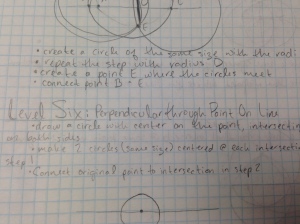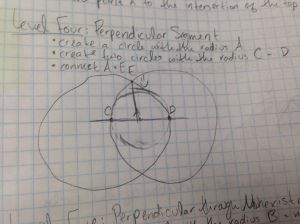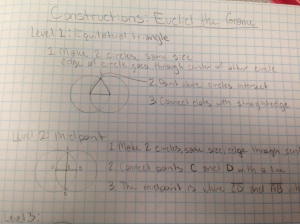Last year I wrote a post about how I wanted to improve my teaching of geometric constructions this year.
This year, I re-read it and used it to help plan this unit better. I never provided the students with steps to make constructions! It was tempting, but I resisted the urge, and they did great!
Here is the sequence that I followed and plan to use next year:
Day 1 – Play with http://sciencevsmagic.net/geo/ see how many of the challenges you can complete. I then had students submit a screen shot of their completed challenges through Google Classroom.
Day 2 – I assigned the construction design project described in my previous constructions post (and linked below). [credit for the designs: Mr. Baroody]
I gave the students compasses and paper to experiment and relate this to the computer task yesterday. They had to complete this at home. There was no discussion of “constructions” just making designs precise and accurate. Here are some students final designs:
Days 3/4 – Working in pairs, students alternated roles for each level of Euclid, the game with one student operating the laptop and the other writing down the steps they used to complete each level. We only completed up to level 6. These steps became their notes for constructions.
(Note: there is a geogebra constructions tutorial here.)
Day 5/6 – Construction station rotation – I randomly assigned groups and students rotated with their groups through different stations completing paper and compass constructions, using Popsicle sticks as their straightedges, so they couldn’t rely on measurements. They used their notes that they developed from playing Euclid the game. Sometimes they noticed that their notes were not sufficient, but since they had new partners, they would compare and add notes & diagrams as needed to improve their descriptions.
Day 6 – Constructions extensions. I asked them to apply their knowledge of constructions to new tasks, such as finding 1/8th of a segment, constructing a equilateral triangle and constructing a rhombus.
Students were so much more proficient at using a compass than at the end of this unit last year!
I think I need to develop more construction extension challenges to build on their basic skills next year. I may make a list of challenges and assign point values to them and then assign a total point value that they can get a variety of ways.
Please comment with any ideas to improve this sequence of tasks as an introduction to constructions that builds student confidence while supporting their creativity and problem solving.













[…] review this edited unit for ideas to […]
[…] 10/05/15: I no longer use this in my classes because I developed a better sequence of lessons for teaching geometry where students deduce each construction using reasoning instead of copying […]
Thanks for sharing! I’d like to try your construction design project but I can’t download it (Scribd isn’t playing nice). Can you post the file in a different format?
I added a Dropbox link to the other constructions post, and I’ll put it here too. Hopefully this works:
here are the example constructions:
https://www.dropbox.com/s/928t18g4keo9y9j/Construction%20Project%20examples.pdf?dl=0
Here is my assignment(editable):
https://www.dropbox.com/s/ijn5g0jzsvk2hpj/Geometry%20Constructions%20Project.docx?dl=0
Hooray! I’m doing constructions next week. I’ll let you know how it goes.
I love that you have them discover the steps for constructions–that’s so huge for me. Maybe it’s because I have such a lousy memory, but I always hated the way every book I’ve ever seen has presented it as a recipe to follow. And to make it worse they only show the arcs that are drawn and not the full circles so there is no connection to why any of it works! I’ve been working on my own revamping of constructions because I think if they are done correctly they require a rich amount of geometric reasoning. Last year I started by giving students a problem which asked them to find the optimal location for an airport. It was an activity I found and revised and it requires them to use perpendicular bisectors and angle bisectors to locate the airport location. I gave students very little direction and they used a stripped down version of GeoGebra that only gave them compass and straightedge tools to use. Once they discovered how to construct perpendicular and angle bisectors, they constructed an equilateral triangle and regular hexagon which led into a project where they had to create mock stained glass windows using Islamic inspired art.
I’ve been looking to improve/add on this year for the rest of the constructions so your post came at the perfect time! Thanks for sharing all of your resources!
I really like how you kicked off the constructions unit by having students explore the patterns and relationships between figures drawn with a compass and straightedge. I can see that it’s much more effective (and engaging) for students to start puzzling out the reasoning behind each construction (i.e. what makes that set of steps valid) before introducing the compass and straightedge. I feel that if we start with the compass and straightedge right away, and have students follow the physical steps of completing a construction, they end up just blindly following the steps without the opportunity to explore WHY they’re taking those steps, and thereby miss out on the richness of the mathematical ideas behind it all. Plus, if we don’t assign meaning to those procedures, it’s harder for students to recall what they need to do to construct such and such.
I also think it’s a brilliant use of technology to introduce constructions with gaming apps. Technology comes to the rescue again, abstracting out the physical labor of doing constructions on paper so that students can focus more on the concepts behind what they are doing.
I recently concluded a practicum as a graduate student in a licensure program for secondary math education. While I was at my placement, I actually had the chance to observe and teach a unit on constructions (what coincidence!). I definitely agree with Sandy above that showing students to draw the arcs without drawing the full circles at least a few times causes students to miss out on a lot of key ideas in geometry (the definition of a circle, for one). When we were teaching our lessons in the unit, we were asked to review with the students why each construction was valid. We were to explain that validity comes from the compass settings being the same, which means that radii are the same. Unfortunately, I felt like I was giving the students words and terms and not presenting what they mean. Without seeing the full circles, it’s pretty hard to see that “the radii are the same”. So where are the radii anyway? (Insert major head-scratching.)
I also had a majorly hard time using the “same compass setting equals same radii” explanation for the segment bisector (which is really the perpendicular bisector). Just for the segment bisector alone, the full proof for the validity of the construction involves triangle congruence theorems applied multiple times; the whole thing is even more complicated for the perpendicular bisector. I feel that constructions would be nice if it were taught *after* certain major concepts, like those triangle congruence theorems. With that prior knowledge, realizing why certain constructions are valid would be much more possible for the students.
[…] Constructions was MUCH better this year! Exploring Length with Geoboards and Desmos First Day Name Tents Five Questions to Ask Your Students […]
This definitely gives me more food for thought than a typical tweet would. Thank you so much
[…] found it more useful to start the school year introducing geometry as art, and developing a need for definitions as students struggle to describe the process to create their […]
[…] the year with constructions in order to see the beauty of Geometry. We randomly do cool art from Lisa Bejarano on days like a Friday of a hard working week or the day after a Thursday night football game. We […]
[…] Constructions Challenge (Lisa Bejarano) […]
[…] Constructions Challenge (Lisa Bejarano) […]
[…] Constructions Challenge (Lisa Bejarano) […]